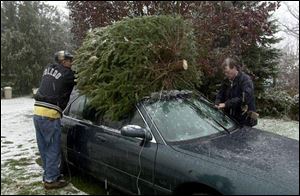
Plan before you buy the holiday tree
12/6/2000As the days get shorter and the lines at the checkout counters get longer, it can only mean one thing . . . the holidays are here.
After the Thanksgiving feast is a memory, and you have applied a generous layer of winterizing fertilizer to your lawn, it is time to head out the door and get your Christmas tree. If you like your tree freshly cut from the field, here are some things to keep in mind while you shop.
CHOOSING THE TREE
The Scotch pine has needles of medium length, with sturdy branches to hold heavy ornaments and lights. If it is kept watered, it will hold its needles well.

Bill Cook of The Farm helps load a fresh tree for the trip home.
White pine has a medium-length needle, like the Scotch, but is much softer to the touch. If you have children, this light-textured tree may be a good choice. The branches aren't as strong as the Scotch pine, and may be too weak for some of the heavier ornaments.
Douglas fir trees are found in the Pacific Northwest, and are usually shipped in to this area. This tree is full, light, and has medium-soft needles. It holds its needles well in warmer environments.
Norway and White spruce trees have a shorter needle and very stiff branches. They have unique coloring and smell wonderful. But, they tend to drop their needles quickly.
WHAT TO LOOK FOR IN A TREE
Look for a straight tree with at least one full side. Always measure the area where the tree will be placed before going to the tree farm. Trees look much smaller in the open field and may actually be too big for a room.
PASSING THE TEST
Do the shake, tug, and break tests on a pre-cut tree to check for freshness.
The shake test: Shake the tree to see if needles drop on the ground. If you see a lot of green needles on the ground, pick another tree.
The tug test: Gently tug on the needles. If more than a couple of them pull off in your hands, the tree is too dry.
The break test: Break off a few needles. They should be flexible, fragrant, and sticky. If a tree passes this rigorous test, it will be a good tree for Santa to stuff gifts under.
BRING IT INSIDE
Before your tree comes inside, blow loose debris out of it with a powerful leaf blower or garden hose. Doing this will remove bugs and loose pine needles. Some Christmas tree vendors may offer to put the tree on a high-powered shaker to remove any unwanted guests.
If it has been over an hour since the tree was cut down, you need to make a fresh cut so the tree will take up water. After an hour, the tree will heal over and without a fresh cut it will dry out quickly.
A few branches may have to be trimmed from the trunk to fit it into the tree stand. Wrap your tree in a blanket when you bring it in the house. This will protect any doorways and floors that may be scratched by the pine boughs.
Keep the tree watered. A fresh tree will drink at least a gallon of water in the first 24 hours; it will slow down after that.
To be sure the tree doesn't drop its needles, keep it watered until you are ready to take it down. Think of your tree as a really big houseplant that needs extra care.
So grab your leather gloves and a warm coat, and start shaking those pine trees.
Kelly Heidbreder is The Blade's garden writer. E-mail her at getgrowingkelly@aol.com.